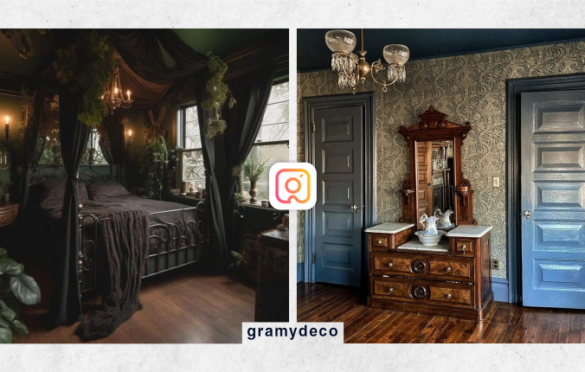Imagine stepping into a space where shadows dance gracefully on the walls, and deep, rich hues embrace you like a comforting embrace. This is the essence of moody interiors—a design trend that traces its origins through a fascinating journey in the world of aesthetics. From the mysterious allure of Gothic architecture to the dramatic sophistication of Art Deco, moody interiors have evolved, intertwining deep colors, sumptuous textures, and subtle lighting to create spaces that are not just rooms but captivating stories waiting to be unraveled.
Darker, moody interiors carries a fascinating history across different historical periods and styles of design. The idea of crafting interiors with an atmospheric, darker ambiance has transformed over the years, influenced by changes in culture, society, and artistic expression. Let’s take a quick journey through the history of these evocative spaces.
Gothic Revival (late 18th to mid-19th century)

The Gothic Revival movement, flourishing during the 18th and 19th centuries, found its muse in medieval Gothic architecture. This period was defined by interiors adorned with elaborate, detailed designs and adorned with sumptuous, opulent fabrics. Dark wood, deep and rich colors, combined with subtle lighting, conjured a dramatic and moody atmosphere, encapsulating the essence of this era.
Victorian Era (mid-19th to early 20th century)

The Victorian era is renowned for its grand and luxurious interiors. These spaces were characterized by opulent elements like weighty furniture, lush velvet drapes, and intricately patterned wallpapers. Deep, vibrant hues like dark reds, purples, and greens were all the rage, adding to the opulence and creating a moody, sumptuous aesthetic that defined the era.
Arts and Crafts Movement (late 19th to early 20th century)

As a response to the extravagance of the Victorian era, the Arts and Crafts Movement emerged, putting a spotlight on skillful craftsmanship, simplicity, and a deep-rooted connection with nature. This movement favored darker, natural tones, and materials such as oak and mahogany to fashion interiors that emanated a welcoming and cozy ambiance, in contrast to the excesses of the preceding Victorian era.
Art Deco (1920s to 1930s)

Art Deco, the epitome of sophistication and glamour, introduced geometric patterns, metallic accents, and luxurious materials to the world of interior design. It embraced deep, bold colors like black, navy, and emerald, often paired with gold or silver accents, culminating in interiors that exuded drama and opulence. This movement revolutionized the way interiors were perceived, bringing forth a lavish and modern aesthetic that continues to captivate to this day.
Mid-20th Century (1940s to 1960s)

After World War II, a significant shift away from the intricate styles of the past took place. Embracing influences from modernism and Scandinavian design, a new era of design emerged. Mid-century modern interiors became prominent, showcasing clean lines, dark wood tones, and a strong emphasis on functionality and minimalism. This departure from opulence marked a fresh and contemporary approach to interior design in the post-war period.
Gothic and Gothic Revival Revival (late 20th century to present)

In the late 20th century and persisting to the present day, there has been a notable resurgence of fascination with Gothic architecture and design. This revival has breathed new life into interior spaces characterized by dark hues and Gothic-inspired features like pointed arches, sumptuously textured fabrics, and carefully crafted atmospheric lighting. These elements converge to craft interiors with a moody and enigmatic ambiance, rekindling the allure of Gothic aesthetics for contemporary sensibilities.
Contemporary Trends (present)

In modern design, darker, moody interiors have surged in popularity for their knack to evoke feelings of coziness, sophistication, and intimacy. Embracing deep, rich colors such as charcoal, deep blues, and dark greens, these interiors are often complemented by plush fabrics, textured finishes, and gentle lighting. This combination comes together to craft a luxurious and inviting atmosphere, redefining contemporary interior aesthetics.
Across history, the fondness for darker, moody interiors has ebbed and flowed, shaped by evolving societal tastes, design trends, and a quest to elicit particular emotions and aesthetics within our living spaces. In contemporary times, this style perseveres, dynamically evolving to align with modern preferences while still retaining its timeless and captivating allure.

